When you think of Havana, you picture quite clearly the historic architecture that hasn’t changed in decades or even more than a century, the warmth of the people, and the culture. Then you wonder how it is in the rest of the country.
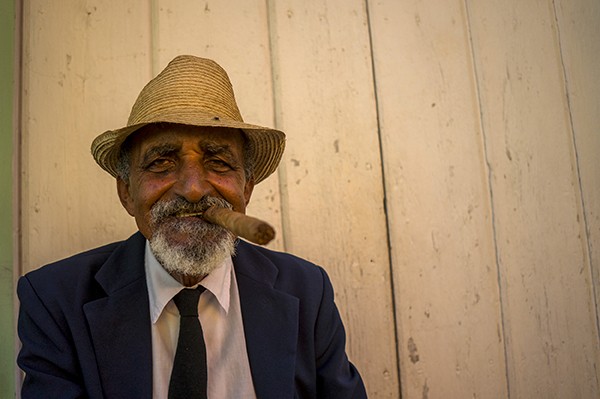
A very charming man willing to take his picture with everyone. Thanks Alby Glaister for sharing this picture.
After Havana, I visited Viñales to get a glimpse of the rural side of the country, and now, I’m heading to Trinidad, which as many have described, it is one of the best preserved colonial towns in Cuba – in fact, in 2014 it turned 500 years old! And I already thought Havana preserved most of its historical architecture – even if they are all in various stages of disrepair.
Welcome To Trinidad
Architecturally, Trinidad lies somewhere in between Viñales and Havana. It is not as rural as Viñales, but it is not as developed as Havana. It preserves a wide range of colonial buildings going from the 16th century to the last century. Many of its streets are still paved with cobblestones and lined with pastel colored buildings with wrought-iron grilles and delicate terracotta tiled roofs.
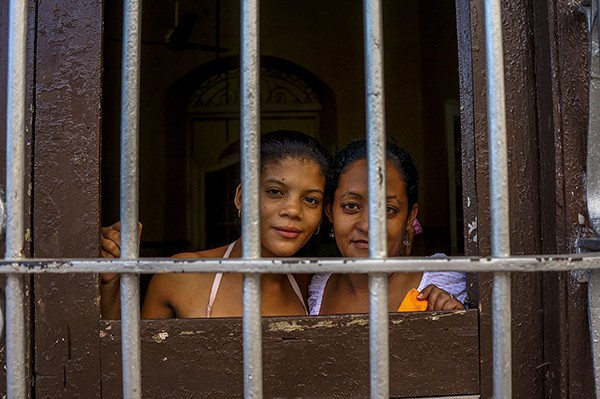
Cubans are very welcoming and friendly, as you’ll experience there. Thanks Alby Glaister for sharing this picture.
After walking a few streets, looking for my Casa Particular, I fell in love with Trinidad – even more than with Viñales and Havana… and I loved those a lot! I think of Trinidad as a historical open air museum where you can see colonial-era history at every corner and even revolutionary history in dedicated places like the History Museum of the city.
To my surprise, my Casa Particular was located right in the center, just a few steps away from the Plaza Mayor and one of the many famous Casa de Música in the city. Trinidad holds a strong cultural bond with music, and you get to feel that right from the moment you step into the city. During the day, the streets are alive with the social gatherings and sense of community from the locals while at night they shift to a music driven environment where you can hear a different live performance at about every corner close to the Plaza Mayor. And if that’s not enough for Trinidad’s musical culture, it also has a few discothèques, including one in the ruins of a church and another one in a large cave formerly used as a wartime hospital. Yes, Trinidad is not shy when it comes to music.
One of my recommendations is not to miss the view from both of the major towers in the city; the one from the Museo Histórico Municipal and the one from the Convent of Saint Francis of Assisi. You get a terrific bird’s eye view of the city and its natural surroundings. Don’t miss it! I went up and took loads of pictures from there and even from all around the city, but as I shared in the previous post, my camera’s SD card got ruined in Cuba, so I only have a few surviving images of Trinidad. Damn it!


Besides the city itself, there’s much more to do around Trinidad, including Topes de Collantes, which is one of Cuba’s premier ecotourism centers and excellent hiking area, located just 20 kilometers away from the city. There’s also the white sand beach of Playa Ancón, which was one of the first new resorts to be developed in Cuba following the 1959 revolution (highly noticeable with the architectural style of the few hotels nearby).
Paradise in Cayo Coco
While Playa Ancón was a nice beach, nothing compares to the beaches in Cayo Coco and Cayo Guillermo.
Initially, I didn’t plan to go there since these islands were out of my way and it is hard to reach them unless you have private transportation (no public transportation in/out of the islands for tourists).
Today, Cayo Coco and Cayo Guillermo are simply referred to the “nice all-inclusive resort islands,” but they have an interesting history behind them.

Cayo Coco used to be a hideout for buccaneers in the early colonial period. Later it served as home to a small settlement of fishermen and charcoal producers until 1955 when the freshwater supply was exhausted, and the market for charcoal ended with the spread of electrification after the Cuban Revolution. Then, the resort era of the islands started in the early 1990s after a causeway was built, linking these small islands to mainland Cuba. And here’s a fun fact… Cayo Coco and the neighboring Cayo Guillermo provided settings for Ernest Hemingway’s Islands In The Stream and The Old Man and the Sea.
So, back to getting to Cayo Coco. As I mentioned, there’s no public transport to reach them, but luckily, I met my friends back in Viñales, and I was still traveling with them. They had a private taxi already rented to go to Cayo Coco, so I happily hopped on with them!
Now, as I mentioned, Cayo Coco is all about resorts, and if you’ve been following me for a while, you know by now I’m a budget traveler. When my friends suggested going with them to the Melia Cayo Coco (all-inclusive resort), I checked the resort prices online, and they ranged in the $250+ per night. I sadly said to them I was not going. Here’s the thing, out of curiosity, I wanted to know if any local agency had a better offer, so I walked in an agency in Trinidad, and to my surprise, they offered the exact rooms in the same resort for around $80 a night! Since it was all inclusive, I didn’t think about it twice and jumped on it.
One thing I learned there is that Cuban resorts offer a “national rate” to tourists buying in local tourism agencies, and in most cases, these rates are less than 50% of the promoted prices online. Cha-ching!
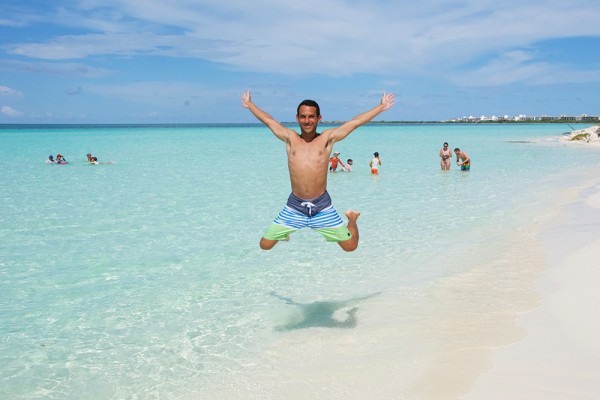
That cha-ching deserved a jumping pic!
Even though resort-travel is not my style, I’m not going to deny that I enjoyed the luxurious pampering of a five-star all-inclusive resort right in front of some of the most gorgeous beaches in Cuba. But ok, I won’t bore you with that part of my trip.
If you come to Cayo Coco, make sure not to miss visiting Playa Pilar in the western tip of Cayo Guillermo. Seriously, this is one of the most beautiful beaches I’ve seen so far. This beach is named after Ernest Hemingway’s yacht, the cabin cruiser Pilar, and it is said to be Fidel Castro’s “go-to” beach in Cuba. Yes, it is that pretty.
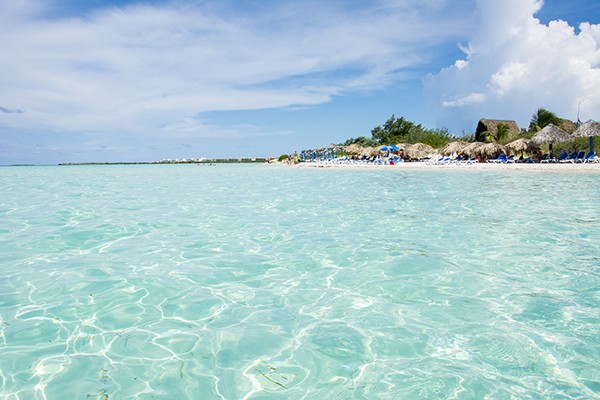
The beautiful Playa Pilar in Cayo Coco, Cuba.
When you travel around the islands, that’s when you see a bit of the segregation between tourists and locals – not on the beach, but on the way you move around. For tourists, there’s a “Hop-on, Hop-off” bus that stops at every resort along the way and ends at the beach. For locals, there’s a local’s only bus that comes from the nearest towns of Morón and Ciego de Avila. None of them mix.
Actually, the beginning of the resort era is known as the “Tourist apartheid” since Cuban citizens were not allowed on the island unless they worked at the resorts serving tourists. However, this restriction was lifted after 2000 and Cubans who can afford private or public transport often come to visit Playa Pilar.
So, yes, take the tourist bus early to spend most of the day at the beach. It is worth it!
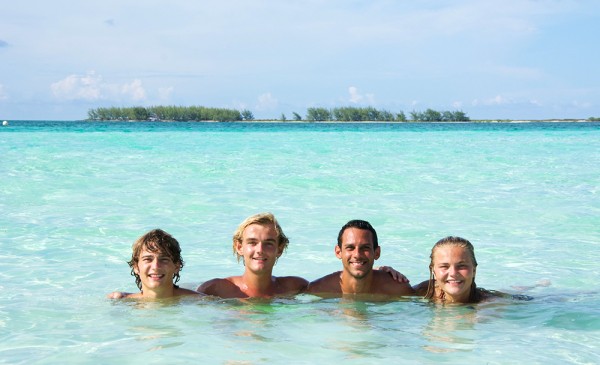
With my friends at the beach.
Posing as a Cuban to Leave Cayo Coco
Coming in was easy thanks to my friends. Leaving was not. I had to return to Havana on my own, and that proved to be a bit of a challenge. There were no public buses for tourists in Cayo Coco, and taxis cost at least $60 to take me to the nearest town to catch the bus back to Havana.
That’s an expensive taxi for me, so I asked at the resort if there were any other option available. The lady, quite cautiously said, “there’s no other option, but, you look Cuban, so you might want to pretend to be a Cuban worker and hop on the free worker’s bus that goes back to town at 6:30 am.”
She even told me how to speak to the driver to pretend to be a Cuban. “Chofe, llevame a Ciego,” was all I had to say and hope for the best with a small bribe in hand.
And that was my plan.
The next morning, I was at the bus station on time, the bus came and dropped a few workers while it picked others finishing their night shift. I stood right at the door of the bus and said my line. The driver refused. I pleaded my case saying I couldn’t afford any other transportation and offered to pay him, but he still refused and left. I was so sad and disappointed.
A lady who got off the bus saw my intentions and told me to wait for another bus and try again. I followed her recommendation and voila, the second bus appeared. I repeated my attempt and… success!
But, I knew I couldn’t call it a victory yet. Everyone who comes in and out of Cayo Coco gets asked for their documents (if you’re a tourist and don’t have a hotel reservation, you can’t even go to the island).
We reached the checkpoint, a guard stepped in and started doing a random document check. As I saw him getting near me, I pretended to be asleep, hoping he would skip me. He stood next to me. I could feel it, but I didn’t want to open my eyes unless he called me directly.
He didn’t. He skipped me and after finishing his random search, he got off the bus and gave the ok to proceed.
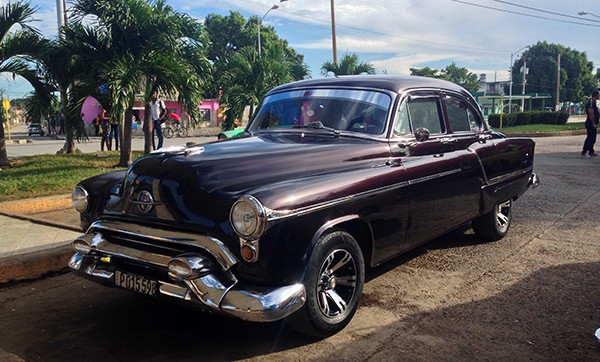
My vintage shared Taxi from Ciego de Avila to Havana.
I was off Cayo Coco and on my way to Ciego the Avila to catch a shared taxi to Havana. What’s best is that this little “I’m a quasi-Cuban” adventure only cost me a small bribe of 5 CUC (about $5) since the bus was free!
Ah, you have no idea how much I’m missing Cuba right now as I write this.
Essential Information
If you’re interested in knowing more about the attractions in Trinidad, you can check this Frommer’s page that gives a great overview of them.
If you’re interested in going to a resort in Cayo Coco or Cayo Guillermo and have some flexibility with time (and it’s not the peak of high season), I recommend making your reservation once in Cuba to save a lot of money on the booking.
While I was successful pretending to be a Cuban to get out of Cayo Coco, this is not a tactic I would recommend (unless you really look like a Cuban – like I do). Unfortunately, taxis are the only “touristy” way out. At the time of writing, they cost $60 to get you to the nearest town.
Don’t miss going to Playa Pilar with the Hop-on, Hop-off bus. It costs 5 CUC round trip from your resort.
Trinidad and Cayo Coco: A Taste Of Music And History In Unexpected Places is a post from: GloboTreks.
Check out my monthly newsletter for additional tips, advice, and updates on travel.